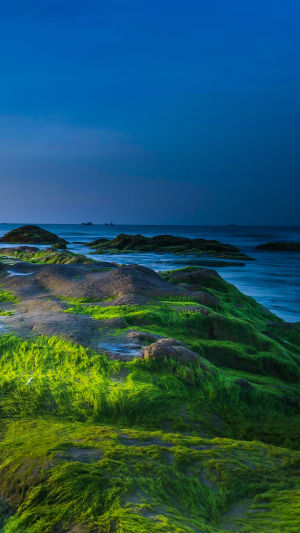What distinguishes kelp, nori, and coral grass, all of which belong to the seaweed family? Seaweeds are abundant in minerals, polysaccharides, Omega 3 fatty acids, and numerous other nutrients, making them significantly superior to land vegetables.
The ocean is teeming with seaweed resources, but are you familiar with them?
According to statistics, there are over 10,000 species of plants that grow in the ocean, most of which are algae. These algae are mainly classified into green algae, yellow algae, golden algae, brown algae, methanogens, diatoms, red algae, cyanobacteria, and eyebright algae, with kelp and wakame being among the brown algae.
Of all the algae in the ocean, brown algae are the tallest, typically growing up to 100 meters tall, with some even reaching heights of 500 meters. These heights are unmatched by any trees on the land.
1. Macroalgae
Giant algae stand tall and soft in the seawater, swaying and floating with the waves, resembling a brown sea grassland from a distance. The growth rate of giant algae is also exceptional; it can grow 30 cm per day and up to 90 cm in the fastest cases. In a year, it can grow into a giant body of 70-80 meters, weighing in at 180 kg.
Giant algae have strong regenerative capabilities, with the ability to be harvested every three months. Once harvested, it can grow a second time, and its lifespan exceeds 10 years with endless offspring. With high nutritional and economic value, giant algae are excellent for protecting coasts and docks.
2. Kelp
Kelp grows on the rocks of the seafloor, with more than 30 species distributed worldwide. It is predominantly found in coastal and bay areas where temperatures are lower, and the wind and waves are smaller. Kelp attaches to shallow seafloor reefs and shells, forming an underwater forest when it reproduces in large numbers, earning it the moniker "crop of the sea."
With high yields, fast growth, large individuals, and high economic value, especially in terms of iodine content, kelp can be directly absorbed by the body. Regular consumption of kelp can prevent and treat goiter.
3. Red algae
Red algae are widely distributed in shallow tropical seas and are dark purple-red in color. After leaving the water and drying, they turn green or gray. Red algae are effective in treating roundworms, children's chilblains, and expelling whipworms and tapeworms.
Red algae are attached to bays, shores, estuaries, and intertidal rocks, with their algae in the shape of a thin film with many pseudo-root-like rounded anchors at the lower end.
4. Chlorella
Chlorella is small in size, simple to reproduce, fast-growing, and rich in protein, particularly in amino acids, unsaturated oleic acid, glucose, and fructose, which are all highly suitable for human consumption. It has earned the reputation of "artificial eggs". In recent years, scientists have studied chlorella as space food, as it can be produced in space, making it the future "cosmic food."
5. Spirulina
Spirulina is a freshwater alga that can only be seen under a microscope in spiral filaments. In the sixteenth century, Spanish explorers discovered that the Aztecs had harvested a "blue mud" from Lake Texaco in Mexico, which turned out to be composed of spirulina. This mud was dried and made into potato chips and bread. Similarly, this algae can be collected from Lake Chad.
Spirulina is still harvested from freshwater today but is also commercially farmed in California, Thailand, India, and China. It is speculated that artificial culture may be less likely to contain impurities when harvested, while naturally collected ones may contain other algae.





